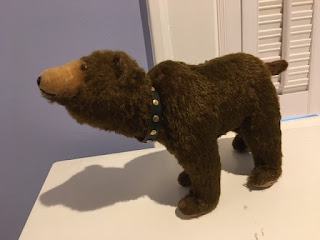This Ted truly stands and delivers. He is 16 cm tall, 30 cm long, and made from brown mohair. His inset muzzle is made from tan mohair. He has tan felt paw pads and four brown hand embroidered claws on each foot. His face comes to life with black and brown glass pupil eyes and a black hand embroidered nose and mouth. Ted is very solidly stuffed with excelsior. What brings him from good to great is the fact that he is a tail moves head example, meaning that he has a little mohair tail that can be moved about in a circle. When this happens, his head rotates in unison. This standing tail moves head bear was produced in 18, 23, and 29 cm from 1930 through 1935. His collar was made by Steiff, but is not original to him.
 Prewar, Steiff produced a number of tail moves head items as part of its strategy to create playful, irresistible, and novel toys for the American and worldwide marketplaces. The company received a patent for their tail moves head mechanism in the early 1930s. Over time about 25 different tail turns head models were produced through the very early 1940s. For the most part, these were based on the best selling standard line patterns of the time and included cats, dogs, rabbits, penguins, goats, and lambs, and even Mickey Mouse, among others.
Prewar, Steiff produced a number of tail moves head items as part of its strategy to create playful, irresistible, and novel toys for the American and worldwide marketplaces. The company received a patent for their tail moves head mechanism in the early 1930s. Over time about 25 different tail turns head models were produced through the very early 1940s. For the most part, these were based on the best selling standard line patterns of the time and included cats, dogs, rabbits, penguins, goats, and lambs, and even Mickey Mouse, among others.  These innovative new toys - designed to get consumers moving and grooving - were featured on a Steiff catalog cover from 1931. You can see that image here on the left. They were promoted as, “The year 1931 has presented us with the animals with the new head movement… The simplicity of the mechanism, though which the splendid movement is produced, cannot be beaten, yet it is unbreakable and allows lifelike play, full of variety and mimics… When buying new supply in plush toys please be sure to include the STEIFF animals with the new head movement; all numbers equipped with it are marked ‘H.’”
These innovative new toys - designed to get consumers moving and grooving - were featured on a Steiff catalog cover from 1931. You can see that image here on the left. They were promoted as, “The year 1931 has presented us with the animals with the new head movement… The simplicity of the mechanism, though which the splendid movement is produced, cannot be beaten, yet it is unbreakable and allows lifelike play, full of variety and mimics… When buying new supply in plush toys please be sure to include the STEIFF animals with the new head movement; all numbers equipped with it are marked ‘H.’”  This tail moves head model was replaced - and possibly upgraded - by another very similar looking brown mohair bear cub in 1935. This was Steiff's snap jointed Circus bear, and he is pictured here on the left. Unlike his earlier tail moves head cousin who was on all fours, the Circus bear was standing. But these two cubs shared a very similar head and muzzle shape, as well as general look and presentation. The Circus bear was 32 cm tall, with disk jointed arms, leg snap joints, and a tail moves head mechanism. He was in the line from 1935 through 1939 and approximately 897 models were manufactured - making him one rare bear indeed.
This tail moves head model was replaced - and possibly upgraded - by another very similar looking brown mohair bear cub in 1935. This was Steiff's snap jointed Circus bear, and he is pictured here on the left. Unlike his earlier tail moves head cousin who was on all fours, the Circus bear was standing. But these two cubs shared a very similar head and muzzle shape, as well as general look and presentation. The Circus bear was 32 cm tall, with disk jointed arms, leg snap joints, and a tail moves head mechanism. He was in the line from 1935 through 1939 and approximately 897 models were manufactured - making him one rare bear indeed.
Steiffgal hopes this discussion about this tail moves head cub has made you want to twist and shout.
Have a question about one of your Steiff treasures? Let's talk! Click here to learn more.





















